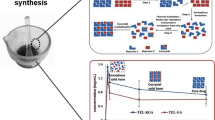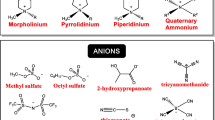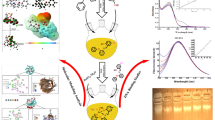Abstract
Δ9-Tetrahydrocannabinol hemisuccinate (THC-HS), an ester prodrug of Δ9-tetrahydrocannabinol (THC) has been investigated for its potential to form inclusion complexes with modified synthetic beta-cyclodextrins (CDs). Phase solubility studies were performed to determine the stoichiometric ratio of complexation of THC-HS with random methylated beta-cyclodextrin (RAMEB) and 2-hydroxypropyl beta-cyclodextrin (HPBCD). THC-HS/RAMEB and THC-HS/HPBCD solid systems were prepared by lyophilization and the lyophilized complexes were characterized by Fourier transform infrared (FT-IR) spectroscopy, proton nuclear magnetic spectroscopy, and molecular modeling techniques. The formation of inclusion complexes of THC-HS/RAMEB and THC-HS/HPBCD was demonstrated by an AL type curve with the slopes less than unity by the phase solubility method. The association constants for THC-HS/RAMEB and THC-HS/HPBCD were found to be 562.48 and 238.83 M−1, respectively. The stoichiometry of both of the complexes was found to be 1:1 as determined from the Job's plot. This was confirmed by 1H NMR and FT-IR techniques. The results obtained from the molecular modeling studies were in accordance with the data obtained from nuclear magnetic resonance and FT-IR. The docking studies revealed the most probable mode of binding of THC-HS with RAMEB in which the alkyl chain was submerged in the hydrophobic pocket of the CD molecule and hydrogen bonding interactions were observed between the hemisuccinate ester side chain of THC-HS and the rim hydroxy groups of RAMEB. The solubility of THC-HS was significantly higher in RAMEB compared to HPBCD. Solid dispersions of THC-HS with CDs will be further utilized to develop oral formulations of THC-HS with enhanced bioavailability.









Similar content being viewed by others
References
Archer RA. The cannabinoids: therapeutic potentials. Annu Rep Med Chem. 1974;9:253–9.
Abrams DI, Hilton JF, Leiser RJ, Shade SB, Elbeik TA, Aweeka FT et al. Short-term effects of cannabinoids in patients with HIV-1 infection: a randomized, placebo-controlled clinical trial. Ann Intern Med. 2003;139(4):258–66.
Abrams DI, Vizoso HP, Shade SB, Jay C, Kelly ME, Benowitz NL. Vaporization as a smokeless cannabis delivery system: a pilot study. Clin Pharmacol Ther. 2007;82(5):572–8.
Adam J, Cowley PM, Kiyoi T, Morrison AJ, Mort CJ. Recent progress in cannabinoid research. Prog Med Chem. 2006;44:207–329.
Adams IB, Martin BR. Cannabis: pharmacology and toxicology in animals and humans. Addiction. 1996;91(11):1585–614.
Agurell S, Halldin M, Lindgren JE, Ohlsson A, Widman M, Gillespie H et al. Pharmacokinetics and metabolism of delta 1-tetrahydrocannabinol and other cannabinoids with emphasis on man. Pharmacol Rev. 1986;38(1):21–43.
Brouwers J, Brewster ME, Augustijns P. Supersaturating drug delivery systems: the answer to solubility-limited oral bioavailability? J Pharm Sci. 2009;98(8):2549–72.
Anderson BD, Conradi RA, Knuth KE. Strategies in the design of solution-stable, water-soluble prodrugs I: a physical-organic approach to pro-moiety selection for 21-esters of corticosteroids. J Pharm Sci. 1985;74(4):365–74.
Aungst BJ, Blake JA, Rogers NJ, Saitoh H, Hussain MA, Ensinger CL et al. Prodrugs to improve the oral bioavailability of a diacidic nonpeptide angiotensin II antagonist. Pharm Res. 1995;12(5):763–7.
Munjal M, Elsohly MA, Repka MA. Polymeric systems for amorphous delta9-tetrahydrocannabinol produced by a hot-melt method. Part II: effect of oxidation mechanisms and chemical interactions on stability. J Pharm Sci. 2006;95(11):2473–85.
Munjal M, ElSohly MA, Repka MA. Chemical stabilization of a delta9-tetrahydrocannabinol prodrug in polymeric matrix systems produced by a hot-melt method: role of microenvironment pH. AAPS PharmSciTech. 2006;7(3):71.
Munjal M, Stodghill SP, Elsohly MA, Repka MA. Polymeric systems for amorphous delta 9-tetrahydrocannabinol produced by a hot-melt method. Part I: chemical and thermal stability during processing. J Pharm Sci. 2006;95(8):1841–53.
Repka MA, ElSohly MA, Munjal M, Ross SA. Temperature stability and bioadhesive properties of delta9-tetrahydrocannabinol incorporated hydroxypropylcellulose polymer matrix systems. Drug Dev Ind Pharm. 2006;32(1):21–32.
Ammar HO, Salama HA, El-Nahhas SA, Elmotasem H. Design and evaluation of chitosan films for transdermal delivery of glimepiride. Curr Drug Deliv. 2008;5(4):290–8.
Ammar HO, Salama HA, Ghorab M, Mahmoud AA. Implication of inclusion complexation of glimepiride in cyclodextrin-polymer systems on its dissolution, stability and therapeutic efficacy. Int J Pharm. 2006;320(1–2):53–7.
Angelova A, Ringard-Lefebvre C, Baszkin A. Drug-cyclodextrin association constants determined by surface tension and surface pressure measurements. J Colloid Interface Sci. 1999;212(2):275–9.
Arima H, Hagiwara Y, Hirayama F, Uekama K. Enhancement of antitumor effect of doxorubicin by its complexation with gamma-cyclodextrin in pegylated liposomes. J Drug Target. 2006;14(4):225–32.
Arima H, Kondo T, Irie T, Uekama K. Enhanced rectal absorption and reduced local irritation of the anti-inflammatory drug ethyl 4-biphenylylacetate in rats by complexation with water-soluble beta-cyclodextrin derivatives and formulation as oleaginous suppository. J Pharm Sci. 1992;81(11):1119–25.
Bilensoy E, Rouf MA, Vural I, Sen M, Hincal AA. Mucoadhesive, thermosensitive, prolonged-release vaginal gel for clotrimazole:beta-cyclodextrin complex. AAPS PharmSciTech. 2006;7(2):E38.
Stella VJ, He Q. Cyclodextrins. Toxicol Pathol. 2008;36(1):30–42.
Monteiro JB, Chiaradia LD, Brandao TA, Magro JD, Yunes RA. Enzymatic hydrolysis of diloxanide furoate in the presence of beta-cyclodextrin and its methylated derivatives. Int J Pharm. 2003;267(1–2):93–100.
Challa R, Ahuja A, Ali J, Khar RK. Cyclodextrins in drug delivery: an updated review. AAPS PharmSciTech. 2005;6(2):E329–57.
Uekama K, Fujinaga T, Hirayama F, Otagiri M, Yamasaki M, Seo H et al. Improvement of the oral bioavailability of digitalis glycosides by cyclodextrin complexation. J Pharm Sci. 1983;72(11):1338–41.
Uekama K, Hirayama F, Yamada Y, Inaba K, Ikeda K. Improvements of dissolution characteristics and chemical stability of 16,16-dimethyl-trans-delta 2-prostaglandin E1 methyl ester by cyclodextrin complexation. J Pharm Sci. 1979;68(8):1059–60.
Carrier RL, Miller LA, Ahmed I. The utility of cyclodextrins for enhancing oral bioavailability. J Control Release. 2007;123(2):78–99.
Hirayama F, Minami K, Uekama K. In-vitro evaluation of biphenylyl acetic acid-beta-cyclodextrin conjugates as colon-targeting prodrugs: drug release behaviour in rat biological media. J Pharm Pharmacol. 1996;48(1):27–31.
Loftsson T, Brewster ME. Pharmaceutical applications of cyclodextrins. 1. Drug solubilization and stabilization. J Pharm Sci. 1996;85(10):1017–25.
Savolainen J, Jarvinen K, Taipale H, Jarho P, Loftsson T, Jarvinen T. Co-administration of a water-soluble polymer increases the usefulness of cyclodextrins in solid oral dosage forms. Pharm Res. 1998;15(11):1696–701.
Al-Marzouqi AH, Elwy HM, Shehadi I, Adem A. Physicochemical properties of antifungal drug–cyclodextrin complexes prepared by supercritical carbon dioxide and by conventional techniques. J Pharm Biomed Anal. 2009;49(2):227–33.
Gillet A, Grammenos A, Compere P, Evrard B, Piel G. Development of a new topical system: drug-in-cyclodextrin-in-deformable liposome. Int J Pharm. 2009;380(1–2):174–80.
Phillip Lee YH, Sathigari S, Jean Lin YJ, Ravis WR, Chadha G, Parsons DL et al. Gefitinib–cyclodextrin inclusion complexes: physico-chemical characterization and dissolution studies. Drug Dev Ind Pharm. 2009;35(9):1113–20.
Higuchi T, Connors KA. Phase-solubility techniques. Adv Anal Chem Instrum. 1965;4:117–212.
Hazekamp A, Verpoorte R. Structure elucidation of the tetrahydrocannabinol complex with randomly methylated beta-cyclodextrin. Eur J Pharm Sci. 2006;29(5):340–7.
Figueiras A, Sarraguca JM, Carvalho RA, Pais AA, Veiga FJ. Interaction of omeprazole with a methylated derivative of beta-cyclodextrin: phase solubility, NMR spectroscopy and molecular simulation. Pharm Res. 2007;24(2):377–89.
Job P. Formation and stability of inorganic complexes in solution. Ann Chim. 1928;9:113–203.
Liu X, Lin HS, Thenmozhiyal JC, Chan SY, Ho PC. Inclusion of acitretin into cyclodextrins: phase solubility, photostability, and physicochemical characterization. J Pharm Sci. 2003;92(12):2449–57.
Barbiric DJ, Castro EA, De Rossi RH. A molecular mechanics study of 1:1 complexes between azobenzene derivatives and beta-cyclodextrin. J Mol Struct Theochem. 2000;532:171–81.
Mannila J, Jarvinen T, Jarvinen K, Tarvainen M, Jarho P. Effects of RM-beta-CD on sublingual bioavailability of delta9-tetrahydrocannabinol in rabbits. Eur J Pharm Sci. 2005;26(1):71–7.
Chen Z, Bradshaw JS, Yi G, Pyo D, Black DR, Zimmerman SS et al. Self-inclusion complexes derived from cyclodextrins: synthesis and characterization of 6A, 6B-Bis-O-[p-(allyloxy)phenyl]-substituted beta-cyclodextrins. J Org Chem. 1996;61(25):8949–55.
Lehmann J, Kleinpeter E. 1H NMR spectroscopy as a probe of intermolecular interactions in β-cyclodextrin inclusion compounds. J Incl Phenom Macrocycl Chem. 1991;10(2):233.
Ali SM, Upadhyay SK. Complexation study of midazolam hydrochloride with beta-cyclodextrin: NMR spectroscopic study in solution. Magn Reson Chem. 2008;46(7):676–9.
Cruz JR, Becker BA, Morris KF, Larive CK. NMR characterization of the host–guest inclusion complex between beta-cyclodextrin and doxepin. Magn Reson Chem. 2008;46(9):838–45.
Kim H, Jeong K, Park H, Jung S. Preference prediction for the stable inclusion complexes between cyclodextrins and monocyclic insoluble chemicals based on Monte Carlo docking simulations. J Incl Phenom Macrocycl Chem. 2006;54(3–4):165–70.
Acknowledgements
The work was supported by grant numbers P20RR021929 (NCRR/NIH) and 2R42GM067304-02 (NIH). The content is solely the responsibility of the authors and does not necessarily represent the official views of the National Center for Research Resources or the National Institutes of Health. The authors also acknowledge the technical expertise provided by Mr. Pankaj Daga from the Department of Medicinal Chemistry for the molecular modeling studies.
Author information
Authors and Affiliations
Corresponding author
Additional information
Guest Editors: Michael Repka, Joseph Reo, Linda Felton, and Stephen Howard
Rights and permissions
About this article
Cite this article
Upadhye, S.B., Kulkarni, S.J., Majumdar, S. et al. Preparation and Characterization of Inclusion Complexes of a Hemisuccinate Ester Prodrug of Δ9-Tetrahydrocannabinol with Modified Beta-Cyclodextrins. AAPS PharmSciTech 11, 509–517 (2010). https://doi.org/10.1208/s12249-010-9401-4
Received:
Accepted:
Published:
Issue Date:
DOI: https://doi.org/10.1208/s12249-010-9401-4




